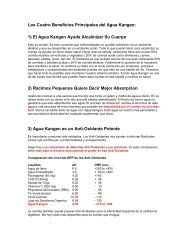ACID-ALKALINE BALANCE: ROLE IN CHRONIC ... - My Kangen Tools
ACID-ALKALINE BALANCE: ROLE IN CHRONIC ... - My Kangen Tools
ACID-ALKALINE BALANCE: ROLE IN CHRONIC ... - My Kangen Tools
Create successful ePaper yourself
Turn your PDF publications into a flip-book with our unique Google optimized e-Paper software.
72 K. Hanaoka et al. / Biophysical Chemistry 107 (2004) 71–82<br />
Oxidative stress w7–12x in the human body is<br />
thought to be due to excess reactive oxygen species<br />
or free radicals including superoxide anion radicals<br />
y<br />
(O 2 •), hydroxyl radicals(•OH), hydroperoxyl rad-<br />
icals (•OOH), nitrogen monoxide radicals (NO•),<br />
1<br />
singlet oxygen(O)and 2 hydrogen peroxide molecules<br />
(H2O). 2 Among these, superoxide anion<br />
radicals are the best known. It is considered that<br />
the dismutation activity for superoxide anion radicals<br />
is the most important indicator of antioxidant<br />
effects. We have studied the antioxidant effects of<br />
reduced water produced by electrolysis w13x. The<br />
commonly reported parameters of reduced water<br />
which are pH, ORP, DO and DH, do not explain<br />
the mechanism of enhanced antioxidant effects but<br />
they are useful parameters for determining the<br />
energy of electrolysis, if measured immediately<br />
after electrolysis. They are the parameters of the<br />
solute in the reduced water. We have investigated<br />
the parameters of the solvent water. The parameter<br />
of the solvent, which is directly related to the<br />
enhancement of dismutation activity by reduced<br />
water is the ionic product of water. We could<br />
obtain the ionic product of water (pK ) by using<br />
w<br />
pH and the neutralization titration method. We<br />
defined the ionic product of water (pK ) as pIP<br />
w<br />
for electrolyzed water. Water passed through the<br />
electrolysis system with no current applied was<br />
used as a control. In this study, pIP and the increase<br />
of entropy have been estimated from the experimental<br />
results. We demonstrate that the reduced<br />
water protects DNA from damage by oxygen<br />
radicals based on the pIP of the reduced water.<br />
The mechanism of the observed antioxidant effects<br />
is discussed in relation to these parameters.<br />
2. Materials and methods<br />
2.1. Electrolysis cell<br />
Two electrolysis half-cells, made of acrylonitrile-butadien-styrene<br />
mounted in polyvinyl chloride<br />
resin, were prepared as shown in Fig. 1. A<br />
non-charged membrane, (YUMICRON Y9201-T,<br />
YUASA CORPORATION) with an effective area<br />
2<br />
of 100 cm and 0.12 mm thickness was mounted<br />
between the two half-cells. Electrolysis was carried<br />
out across the non-charged membrane between<br />
Fig. 1. Electrolysis cells made of an acrylonitrile–butadien–<br />
styrene mounted in polyvinyl chloride resin. (A) anode, (C)<br />
chathode,(M) non-charged membrane,(ES) electrolyte solutions,<br />
(ECS) electrolyzed cathode solutions (the reduced<br />
water), (EAS) electrolyzed anode solutions (the oxidized<br />
water),(PS) electric power source and(p) pump.<br />
these two half-cells equipped with platinum-coated<br />
titanium electrodes having an effective area of 100<br />
2<br />
cm on the cathode.<br />
2.2. Chemicals and reagents<br />
The reagents used for this study were specialgrade<br />
NaCl, KCl, MgCl 2, CaCl 2, L-ascorbic acid<br />
(Wako Pure Chemical Industries Co., Ltd.), and<br />
as a solvent, water, which was distilled and deionized<br />
with an ion-exchange resin to below 0.3 ms<br />
y1<br />
cm . To measure the superoxide dismutation<br />
activity, a sodium phosphate buffer containing 2<br />
mM hypoxanthine(Sigma Chemical Company), a<br />
sodium phosphate buffer containing, 5,5-dimethyl-<br />
1-pyrroline-oxide (DMPO, Labotec Co., Ltd.),<br />
superoxide dismutase (Boehringer Manheim), 0.4<br />
y1<br />
unit ml xanthine oxidase in sodium phosphate<br />
buffer (Merck and Co., Inc.) and L-ascorbic acid<br />
(AsA) were used. FX-174RF1 plasmid DNA<br />
(New England Biolabs, Beverly, MA), H O , 2 2<br />
CuSO , hydroquinone, Tris base, sodium acetate,<br />
4<br />
EDTA, and ethidium bromide (Sigma Chemical



